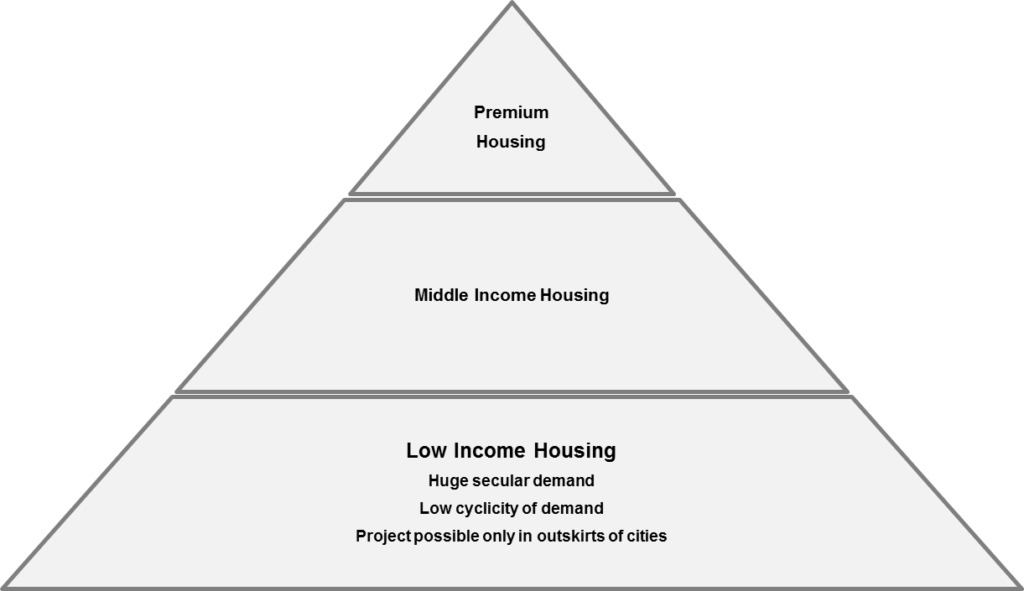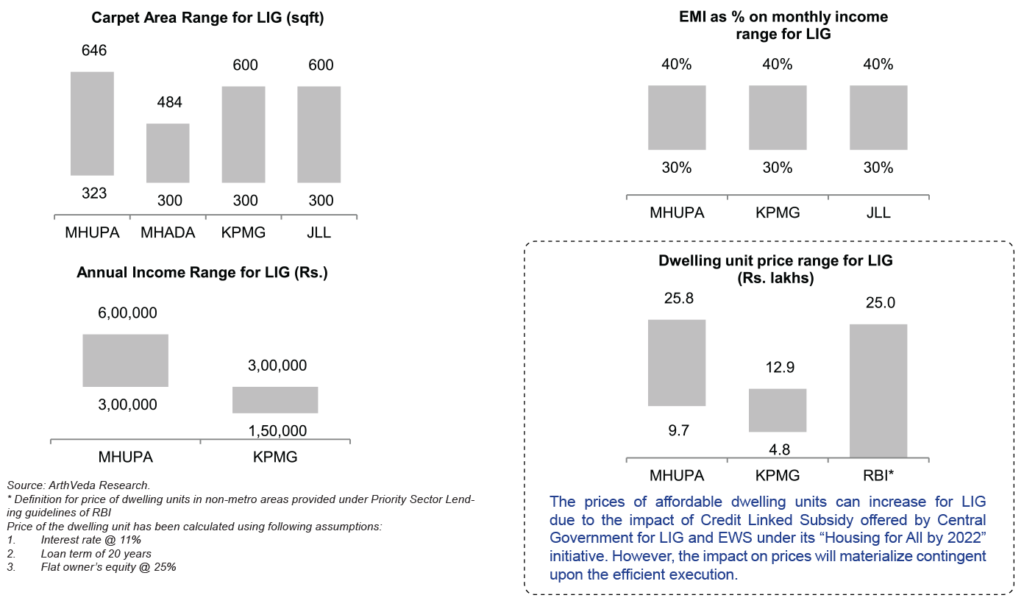Investment Rationale
- Why invest in Low Income Housing?
Real Estate sector is the backbone of the Indian economy, contributing ~10% of the GDP. The housing sector alone contributes 5 – 6% to the country’s GDP. Real Estate is the 2nd largest source of employment in India. Market size of the Real Estate sector is expected to touch US$ 180 billion by 2020 from USD 121 billion in 2013, growing at a CAGR of ~6%.
Real Estate comprises of four broad sub-sectors – residential, retail, hospitality and commercial. Residential Real Estate is the most attractive of all these sectors because of a huge secular demand in the segment. Several factors such as population growth, migration, urbanization, nuclearization, income growth drive this secular demand.
Residential Market can be further divided into three broad categories – Low Income Housing, Middle Income Housing and Premium Housing. With home pricing outpacing the rate of inflation, premium tier 1 houses have become unaffordable, thereby creating a strong demand for affordable homes. Indian culture promotes the idea of owning a home. Even the lower income group prefers owning a house instead of renting one. This is an important determinant for affordable home supply.

Sweet Spot of Indian Residential Real Estate Market – Low Income Housing (LIH)
Housing shortage for Low Income Groups (LIG) stood at 7.41 million units in 2012, accounting for ~40% of the total housing shortage, according to NHB. Although, shortage for Economically Weaker Sections (EWS) accounts for 56% of the total shortage, EWS housing projects are difficult, perhaps impossible, without the Government intervention. Low Income Housing on the other hand enjoys the benefit of a huge secular demand while being possible commercially in the outskirts of cities.
The huge supply demand gap in the segment ensures fast sales velocity and therefore fast exits for the investors. Nearly 70% of the total supply of Low Income Units launched in the two six month periods of June ’11 – Nov ’11 and Dec ’11 – May ’12 was reported to be sold within the period, according to a report – “State of low income housing” by Monitor Deloitte. Low Income Housing, therefore, lies in a sweet spot in the Indian Real Estate Market with low risks and attractive returns.
Show data by KPMG as well in the below illustration

Why does the gap exist?

How is Government addressing the gap?

However, as shown below, Government has achieved limited success in improving the dwelling conditions of LIG and EWS. Total housing supply under different Government Schemes is only microscopic when compared to the size of the overall housing shortage.
JNNURM: Out of 14.41 lakh houses approved in 947 cities, 8.31 lakh houses have been completed, 3.61 lakh houses are under progress.
RAY: Out of 1.2 lakh houses approved in 116 cities, 1154 houses have been completed, 18281 houses under progress
AHP: Out of 20,472 houses approved in 5 cities of 3 states, 4528 houses have been completed, and 2240 are in progress.
First-mover advantage: The Low Income Housing segment has attracted little attention from large institutions because of several reasons; the most prominent of them include lack of scalability, sporadic nature of investments and “seemingly” higher risks. Investments in Low Income Housing require on-ground presence and knowledge of the local market in outskirts of Metros, Tier 1 / 2 / 3 cities. ArthVeda is able to address the risks associated with Low Income Housing Investments because of its unique strengths arising from the presence of Group Companies in the target segment and because of a unique investment strategy.
An unparalleled understanding of risks in Low/Mid Income Housing

Why invest in ASHA Fund?
- A unique proposition: Only fund with institutional focus on Low Income Housing
- Diversification: Exposure to 15-20 projects across multiple geographies and multiple developers
- Grow with India: Modi government’s recent initiative “Housing for All by 2022” is expected to provide push to Low Income Housing
- Backed by strong research and investment expertise: Investment research and strategy is backed by extensive on-ground research, secondary research and expertise of the Group
- Attractive returns: The fund targets 25% gross IRR returns. High returns are possible because of low land-to-sales value (target land-to-sales value below 25%)
- Risk control: Risks have been eliminated, mitigated, or controlled by applying ArthVeda’s unique framework. ArthVeda’s on-ground presence, through its group companies, reduces the overall risk of investments in Low Income Housing.
- High sales velocity, because of huge housing shortage, ensures fast exits
- Focus on small scale, quick-turnaround Low Income Housing projects to further reduce the risk
- Tax optimization: Investment instruments in the SPV have been chosen to lower taxes at the hands of the investors
- High transparency: All fund accounting done externally by a third-party
Leverage capabilities of Group Companies to lower risk

